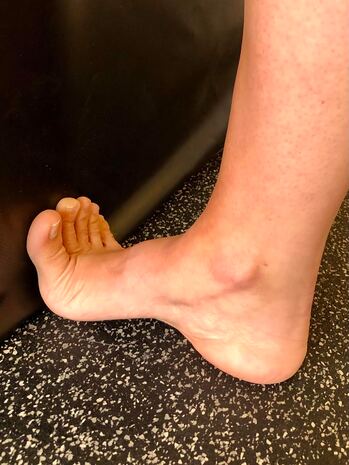10 Functional Assessment Screens for Runners
Jul 01, 2021Here are my 10 favorite baseline prerequisite screens for runners. These screens test for mobility, strength, and your ability to control your trunk, pelvis and hips. Making sure you are able to pass these screens is a good way to reduce your risk of injury and to enhance your running performance and economy. These tests can also provide an opportunity to assess areas you may need to focus on during your strength and mobility training.
1. Big Toe Extension (see above below): The ability to extend through the big toe is important for progressing your body over your planted foot while running. If you cannot extend your big toe, you will often see compensatory strategies from the leg or lower back above. We would like to attain ~70 degrees of big toe extension. Using a wall or doorway, try stretching your big toe, allowing the ball of your foot to reach the floor.

2. Ankle Dorsiflexion Wall Test:
The same concept applies for progressing through your ankle. If you have calf tightness or limited ankle joint mobility, you may struggle to progress your shin forward. You will often see compensations from the leg and back above or from the midfoot below. For running, we would like to attain ~30 degrees of forward mobility (ankle dorsiflexion).
3. Hip Extension:
Hip extension is the third aspect of progressing the body forward over the stance leg during running. Since running is mostly a mid range sport for the hip, ~five degrees of hip extension would be adequate, as long as there is no compensation from the lower back muscles. Keeping the front of the pelvis on the floor during this test should help assess hip mobility without compensating from the lower back.
4. Single Leg Heel Raise:
Assessing calf strength and endurance is vital for distance running. During this test, perform the heel raise at a tempo of one second up/one second down per heel raise. Set up using a small plate, or step, to achieve a small amount of ankle dorsiflexion. Come up to a complete calf raise for each repetition and stop if you are unable to elevate to the top of your calf raise height. We would like to see ~30 repetitions.
5. Single Leg Hop Test:
This test assesses the ability to absorb loads and create tension in the calf complex. We would like to see one-second hops for at least one minute.
6. Lateral Heel Tap:
This test assesses your balance, pelvic and hip muscle control, and also assesses the mobility needs at the ankle required for running. Using an eight-inch step, tap the ground with your heel directly to the side.
7. Rear Foot Elevated Split Squat (RFESS):
This is another good test for balance and hip control, as well as the ability to generate force through the leg complex. We would like to achieve 10 repetitions without compensation and to maintain good balance throughout each rep.
8. Single Leg Hamstring Bridge:
The repeated hamstring bridge is a great way to assess the strength and endurance of the muscles behind the leg. During the test, perform a single leg bridge at a tempo of one second up/one second down per rep. Perform from regular 18” bench/chair height. Try to create a straight line from the knee/hip/shoulder, showing good hip extension each rep. We would like to see 30 repetitions.
9. Single Leg Bridge Hold:
During the single leg bridge hold, we are assessing your ability to maintain good hip, pelvis, and lumbar control while engaging the gluteal and hamstring muscles. Hold for 30 seconds without compensating at the hip, pelvis, or lower back.
10. Side Plank
This is a good test for assessing muscle endurance of the lateral hip and oblique abdominal muscles. Without proper hip and core muscle endurance, there will likely be compensatory pelvic drop or lower back muscle use to maintain pelvic and hip control. Perform a side plank from the floor with the opposite leg raised. This can be performed on a GHR machine if you have shoulder issues. We would like to see comfortable holds for longer than one minute without dropping the pelvis.
You should be looking for any difficulty maintaining these test positions, any loss of balance issues, or any mobility restrictions required during these tests. If you notice any of these deficits, this is a good opportunity to address your needs during your strength and mobility training sessions. If you are unsure of your results, or would like an expert eye for your assessment, feel free to contact us!
Thank you and happy running!
- Sam Gillespie PT, DPT, OCS
Let us help you figure out to live your best active life today!
Remember, Movement is Medicine!

